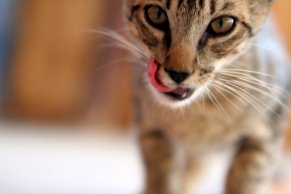What started as a simple idea- find a few differences between wet and dry food for cats- has now officially escalated into a self-led crusade to rid the world of dry cat food. Or, more realistically, start a conversation about what we are feeding our cats. Now before I surge onward I want to profess that my kitties, yes all four of them, have been eating premium dry food for years and all are healthy. I might add that my six water stations, including a water fountain, contribute greatly to this. But much of what I learned helped me to round out my knowledge of their dietary needs, understand which part of their diet is lacking and gave me the knowledge to make better, informed choices on what my kitties should be eating.
Cats, I have learned, are obligate carnivores meaning they need muscle based meats in their diet. Specifically, cats require the essential amino acid taurine, exclusively found in animal protein and critical for normal heart function, vision, digestion and maintaining a healthy immune system.
Aside from needing taurine, our kitties rely on food for one other vital component –water. Wild cats get nearly their entire required water intake from prey. This means 70%-80% of prey is water. This means cats that receive 70% of their water from food do not drink much water on their own. This also means that cats eating a diet less than 60% water can become dehydrated if they are not drinking enough additional water.
I will divert off my food expedition and stop for a moment at the waterfront. Cats, unlike dogs, take longer and are much slower to initiate water drinking when dehydrated. Kitties often do not consume enough water when dehydrated to fully restore themselves to a hydrated state. A quick comparison at the watering hole: dogs will replenish six percent of body weight in one hour whereas cats take 24 hours.
Now, as my steady procession propels me forward, let’s peer a little further into water content. Wet food is typically around 78% water. On average most dry foods contain a whomping ten percent. This low water content has one upside- it is cheaper to buy. However, cats on a strictly dry diet are only consuming half the amount of water needed to stay hydrated. Continue reading

